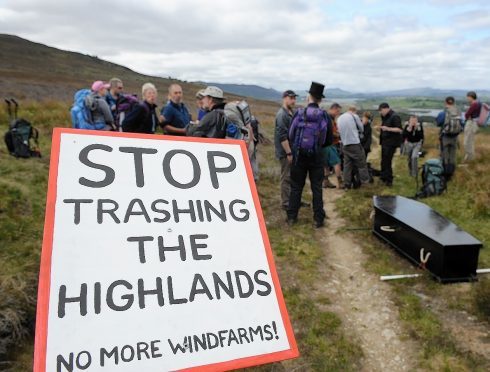The leader of Highland Council yesterday declared “enough is enough” for windfarm construction around Loch Ness.
Margaret Davidson and her colleagues rejected a proposal for 12 turbines to add to hundreds already built within a 22-mile radius of the iconic spot.
She said the region had already surpassed a target for renewable energy generation, and the cumulative effect of hundreds of massive wind schemes circling the loch was threatening tourism.
Mrs Davidson, who represents a lochside ward, admitted she had come round to agreeing with the objectors who have campaigned for years to halt the spread of what have been dubbed the Loch Ness “monsters” sprouting up on nearby hillsides.
She made the comments as the south area planning committee discussed RES’s plans for the Aberarder Estate, close to the existing Dunmaglass scheme.
Barely half the committee was present for the discussion because few had attended a site visit the previous day to qualify them for inclusion, as other ward business had kept them busy in Badenoch and Nairn.
Concerned about the visual and cumulative impact of the latest 427ft tall turbines, Mrs Davidson said: “We’ve more than met the targets we were set in Highland around renewable energy generation. We’ve got more coming on stream all the time and there are other potential ones.
“This will be visual for miles along the Great Glen Way which has around 20,000-30,000 users a year.”
She said she had previously considered a protest video produced last year by the Friends of the Great Glen was an overstatement, but now agrees that a “ring of steel” of huge turbines tightening its grip meant “enough is enough.”
Liberal Democrat councillor Thomas Prag disagreed, insisting the Aberarder project was “probably a good design as windfarms go because it uses the contours and tries to blend with the ones
behind.”
He argued that the visual impact “from most angles” was “actually not significant.”
John Ford, a veteran Labour city councillor and a former engineer, told colleagues that a better mix of electricity was required and that the amount wind generated energy was excessive.
The location at Aberarder has no specific environmental designation, but lies within 12 miles of 15 sites of special scientific interest, seven special areas of conservation and four special protection areas.
RES believe they have designed a windfarm that would not be visible from Loch Ness.
Considering whether they will appeal the decision, development manager John Appleton said: “We’re disappointed. We worked extremely hard to ensure that the windfarm was in line with planning policy and we consulted the local community to bring forward a project that attracted few local objections.”
Jim Treasurer of the Friends of the Great Glen, which sponsored the Save Loch Ness and the Great Glen petition to halt the spread of windfarms within a 22-mile radius of the loch, was delighted.
He said: “We’re really pleased the council leader and committee members recognise the genuine concerns about the potential impact of over-development and the ruinous effect of over 500 wind turbines.
“Most of the Highlands has reached saturation point in onshore windfarm development that destroys our most beautiful areas. It’s perverse to call these developments ‘green’ when they could destroy the core attraction of the lifeline Highland visitor economy.”
Jenny Hogan of the trade body Scottish Renewables said: “As Scotland moves towards an increasingly low carbon economy in order to mitigate climate change, it’s important that areas with the greatest renewable energy resources play to their strengths.
“Renewables generate the equivalent of 57% of Scotland’s power needs, with onshore wind making up more than half of this.”










